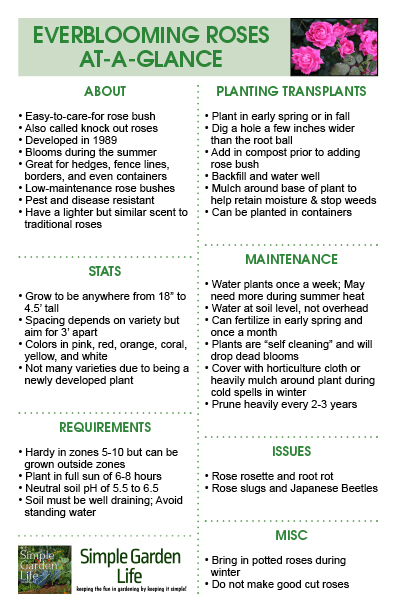The sweet fragrance of rose blooms is the perfect addition to any garden. However, traditional roses can be a bit finicky to grow and maintain. That’s why growing everblooming roses are an excellent alternative, and why they are known as the easy-care rose bush!
Everblooming roses, also known as knock out roses, were created by Will Radler in 1989 as an easy care rose alternative to traditional rose bushes. They are a great choice for beginners and avid rose enthusiasts alike.
They work perfectly for bringing color to almost any location on your property. With their long blooming cycles and beautiful blooms, they are stunning along borders, fence lines, or when grown as hedges. Everblooming roses even work great in containers, too.
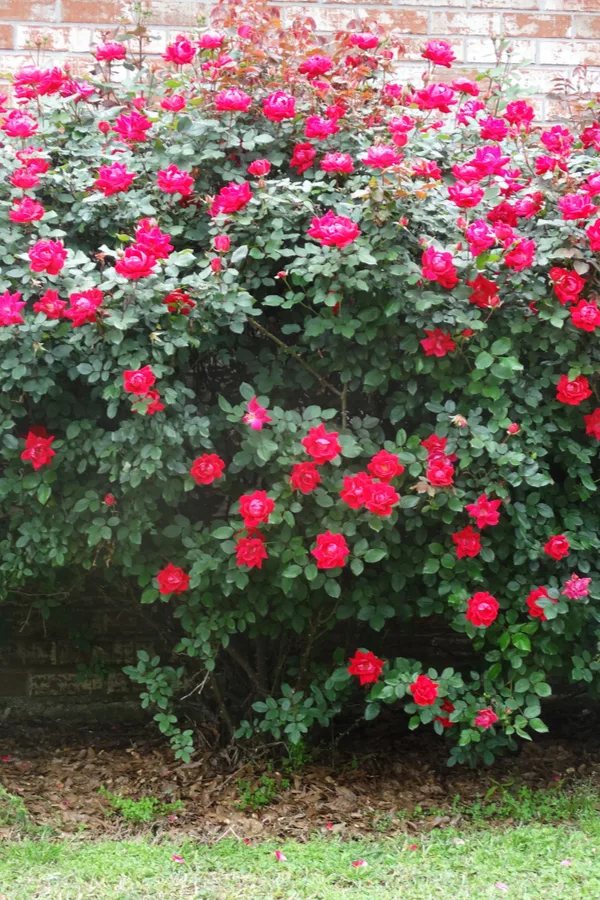
Not only are they low-maintenance, but they are also pest and disease resistant as well. In fact, they are even resistant to black spot disease – the bane of rose growers!
Most varieties are hardy in growing zones 5-10, but everblooming roses can also be grown outside of those zones with a bit of additional care. (You can find your growing zone by visiting Here.)
Varieties of Knock Out Roses – How To Grow Everblooming Roses
Because everblooming roses haven’t been around for as long as traditional roses, there isn’t a huge range of varieties. However, as time goes along, there are sure to be more styles of these knock out roses added to the list.
For the varieties that are available, they do range in size and color. Some varieties grow only to be 18 inches high. Others, meanwhile, can range up to 4.5 feet wide and tall. It really does make them a great choice no matter what your growing location might have for space.
You can find everblooming roses in pink, red, orange, coral, yellow, and white hues. They make a great addition to other traditional flower favorites like peonies, coneflowers, and sunflowers.
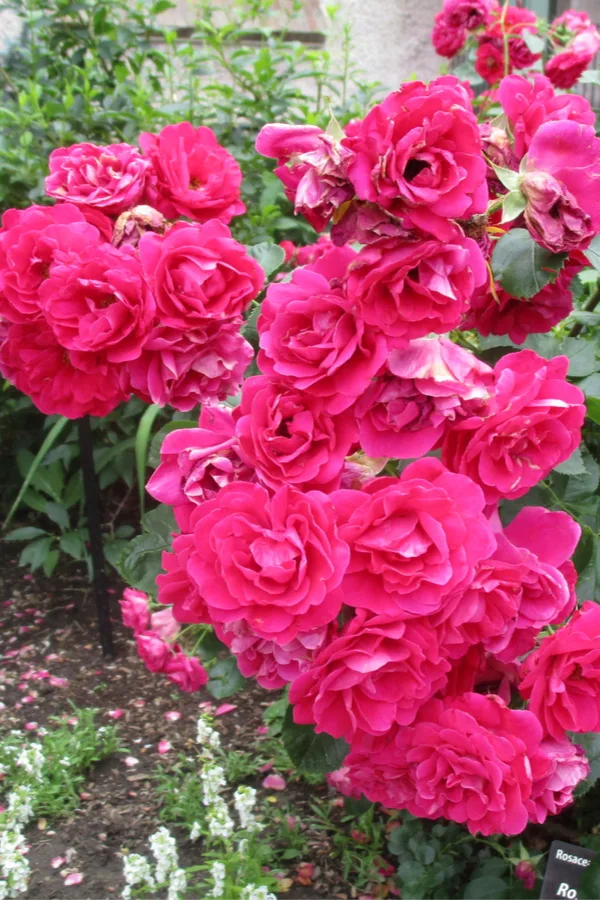
How To Plant, Grow, And Maintain Everblooming Roses
Soil Requirements for Everblooming Roses
These knock out roses prefer a neutral soil pH of around 5.5 to 6.5, but aren’t too picky as long as the soil is well draining. If your soil is heavy like clay, you will need to amend it with plenty of organic matter so it can drain easily.
It is best to plant everblooming roses in the spring or fall when the plant is dormant. This allows the root system to become established prior to the flowers producing blooms in the summer.
Planting Everblooming Roses
Choose a location that allows for full sun (around 6 to 8 hours each day). Morning sun is preferred over the hot rays of the afternoon sun if you can help it. Everblooming roses will still grow in partial shade, but this may affect the amount of growth and blooms produced on the plant.
Create a hole that is a few inches larger than the rose’s root ball. Using a post-hole digger makes quick work of planting. Add a few inches of compost into the hole and place your plant inside. The roots should be completely under the soil line. Back fill with soil and water well.
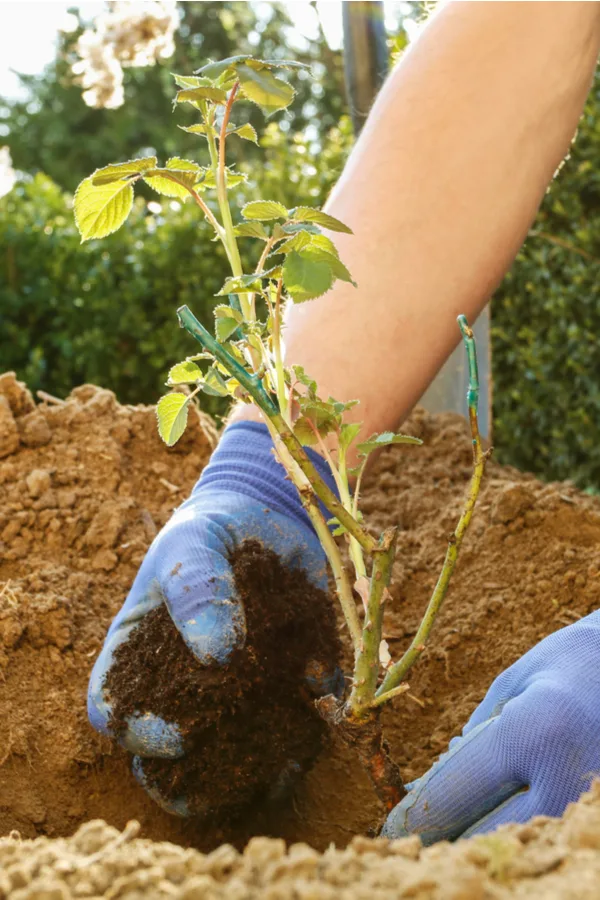
You can consider staking the rose bush at this time as well to provide extra support as the plant grows. This may be needed more for taller varieties and in locations that receive high winds.
Spacing will depend on which type of knock out rose you are planting. In general, aim to keep plants around 3 feet apart to allow plenty of good air circulation.
Planting In Containers
You can also grow everblooming roses in containers. Choose a pot that is about twice the size of the current plant to allow for additional growth. Ensure that the container has good drainage holes. Make sure to add additional holes if needed.
Add potting soil that is rich in organic matter, making sure to add a good amount of compost into the mix. Create a hole that is the size of the root ball and place the plant inside. Be sure the roots are completely below the soil line. Back fill in the same method as regular planting, and water well.
Long-Term Care – How To Grow and Maintain Everblooming Roses
As mentioned earlier, these knock out roses are fairly low maintenance compared to traditional roses. However, there are a few tips to keep in mind to ensure that your flowers grow and flourish.
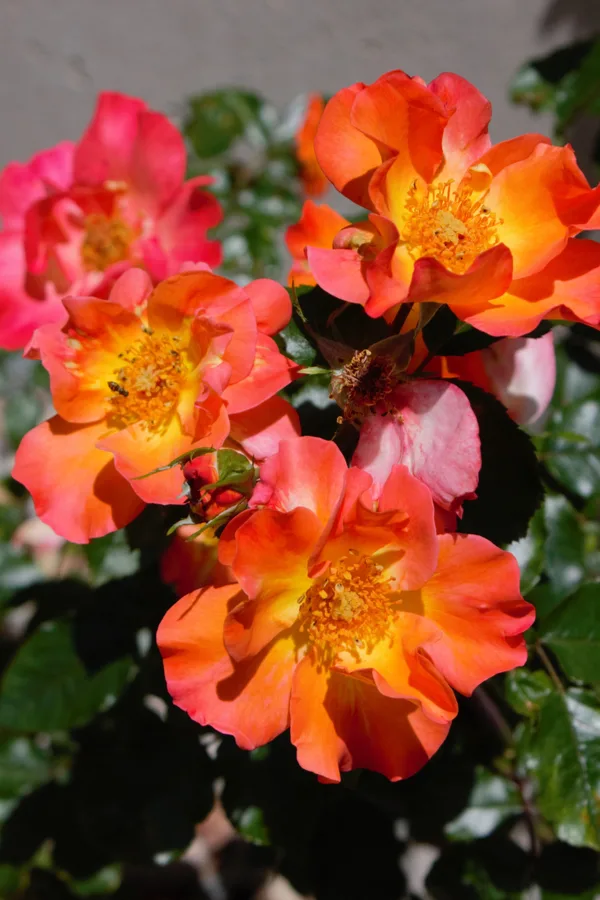
Watering
Unlike traditional roses, everblooming roses only need occasional watering to grow. Over-watering can actually cause root rot and other disease issues with your roses bushes.
Aim for watering your everblooming roses about once a week. In the high heat of summer, you may need to water more often. Also, keep in mind that container plants will likely need to be watered more often than those planted directly in the ground.
To check on whether the plants need to be watered or not, take your fingers and feel down a couple of inches into the soil. If it is damp, you can wait to water. If it feels dry, make sure to water well.
Always water everblooming roses at the soil level to avoid excess moisture on the foliage. If possible, water during the early morning hours to allow the excess moisture to dry before temperatures drop at night.
Mulching
To help your growing everblooming bushes retain more moisture, consider adding a few inches of natural mulch around the plant’s stem. Avoid allowing the mulch to actually touch the stem since this can cause additional issues.
Using mulch can also help to reduce weeds and protect the plant’s roots during the colder winter months. To learn more about using mulch and what materials to use, make sure to read, “How To Use Mulch”.
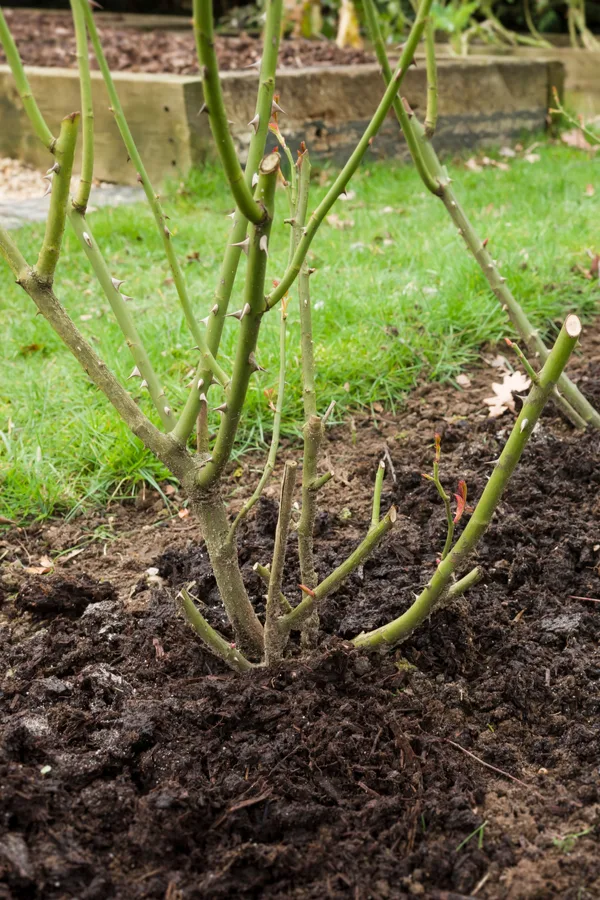
Fertilizing
While you don’t have to use fertilizers to grow your everblooming roses, it is beneficial to give the plants a good dose of organic, all-purpose liquid fertilizer during their first spring. This helps to promote blooming and additional plant growth.
You can continue to fertilize monthly during each growing season, but make sure to stop at the end of summer. Continue fertilizing in early spring.
Deadheading
Everblooming roses are actually “self-cleaning” roses. This means that the new blooms simply drop the spent dead blooms. Because of this, there is no reason for deadheading. You may choose to deadhead, however, because this helps to keep plants looking tidy.
Pests & Issues
While everblooming roses are excellent to grow since they are mostly disease and pest resistant, there are still a few issues to keep in mind.
These knock out roses are most susceptible to rose rosette. This is a virus that spreads by tiny mites that carry the disease directly to the rose bush. If you start to see bright red new growth coming out of the stem, be sure to prune quickly and remove all infected foliage, cutting back to the healthy green stems.
When rose rosette is not caught early enough, the bush will begin to die and the virus will quickly spread to other nearby rose bushes.
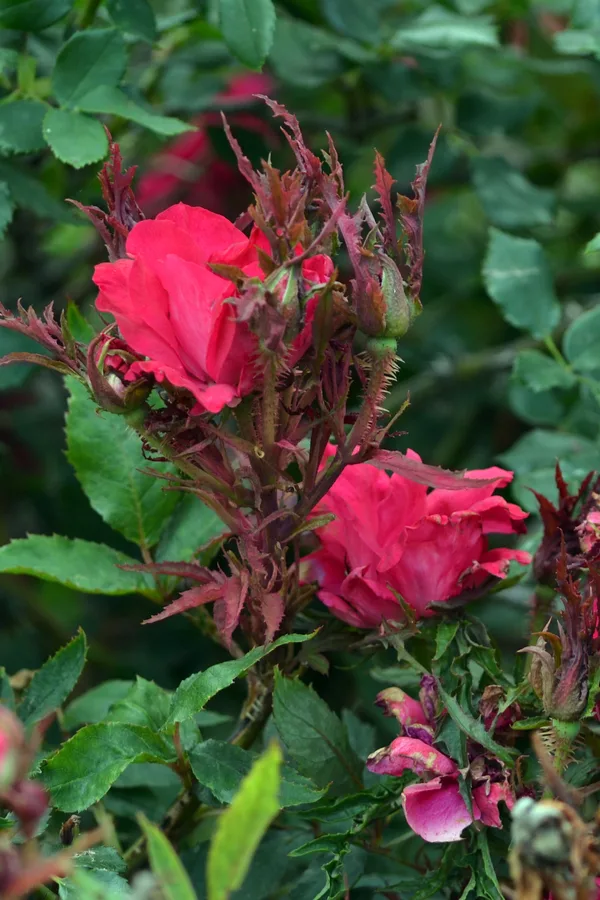
In addition, everblooming roses are also susceptible to rose slugs and Japanese beetles. However, regular checks of the plants and removal of any infestation will help to keep these pests under control.
Pruning
Even though these knock out roses are “self cleaning,” you may want to consider pruning them in early spring or in the late fall. This helps to keep them tidy as well as to encourage summer blooms.
In addition, aim for removing about two-thirds of each rose bush every two to three years. This will help to keep growth under control and to promote thicker, bushier plants.
Winter Care
In colder growing zones, your everblooming roses will need a bit of help during the colder winter months.
Adding a thick layer of mulch around the base of the plants will help to insulate the roots. Use straw, leaves, grass clippings, or any other organic mulch. You can also choose to cover the plants with light sheets or horticulture cloth during long cold spells or freezes.
Keep in mind that container roses may need to be brought indoors during the colder winter months since the roots of potted plants do not get as much protection from the elements as a plant that is grown in the ground.
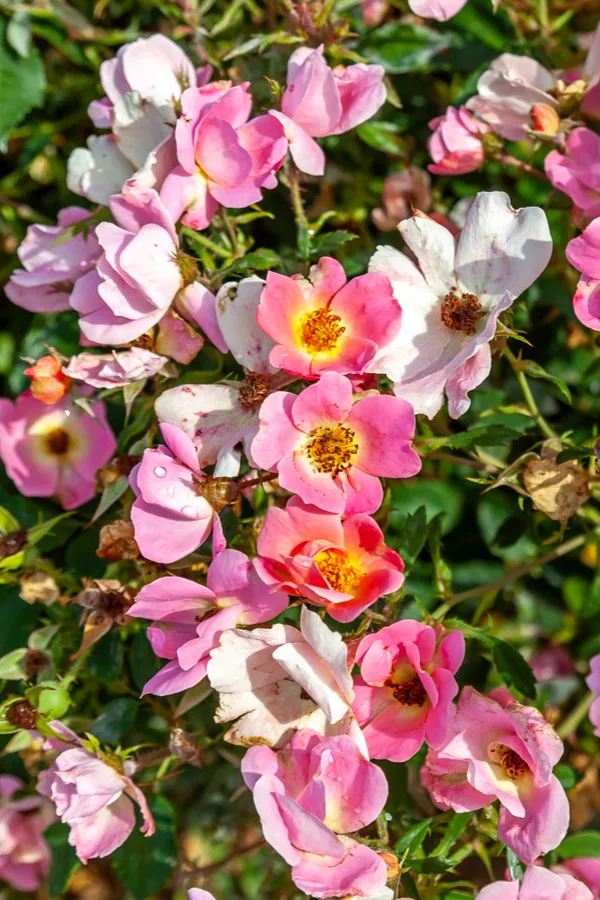
Cut Roses
Even though these roses produce beautiful, lightly-fragranced blooms, they do not make good cut roses. The blooms simply do not last long once they are off of the plant. Save your flower displays and arrangements for traditional roses.
To Conclude…
If you love the scent and beauty of traditional roses but aren’t a fan of how much work they take, make sure to consider growing everblooming roses for your property instead. You can still enjoy all of the perks of the classic rose bushes but without all the hassle!
Feel free to download, print out, or save our Everblooming Roses At-A-Glance sheet. The size is for half letter printing but it can scale as well for the size you need.
Follow Our Facebook Page For Even More Great Tips! Simple Garden Life Facebook Page
Simple Garden Life is a website dedicated to keeping gardening fun, simple and enjoyable! We publish two new articles each week along with a new garden podcast episode every two weeks. This article may contain affiliate links.
